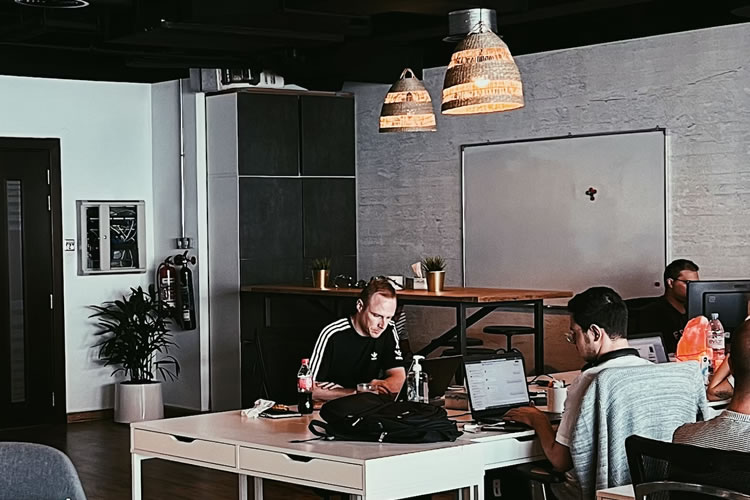Montreal Web Design: Crafting Your Digital Dreams
![]() by Fabio Peters
by Fabio Peters

In the energetic metropolis of Montreal, where culture and creativity intertwine, the world of web design has emerged as a vibrant and essential facet of modern business and communication. With the digital landscape evolving rapidly, having a strong online presence is not just a choice, but a necessity for businesses of all sizes. This is where the skilled and innovative web designer services in Montreal come into play, crafting digital experiences that captivate, engage, and drive success.
Cutting Edge Web Design
Montreal has long been renowned for its artistic and technological prowess, making it a natural breeding ground for cutting-edge web design. Web designers in the city are not just code wizards, but artists who understand the delicate balance between aesthetics and functionality. They have an uncanny ability to translate a brand’s essence into a visually appealing digital canvas that resonates with the target audience.
From minimalist layouts that exude elegance to bold and vibrant designs that scream creativity, Montreal’s web designers exhibit a range of styles that cater to diverse business needs. This fusion of artistry and technology results in websites that are not only visually striking but also seamlessly navigable, ensuring an optimal user experience.
Custom Website Development
One of the standout features of web designer services in Montreal is their commitment to providing tailored solutions. They recognize that each business is unique, and a one-size-fits-all approach simply won’t suffice. Whether it’s a startup looking to make its mark, an e-commerce platform aiming for high conversion rates, or a corporate entity seeking to enhance its online presence, Montreal’s web designers are equipped to handle a wide spectrum of requirements.
Collaboration lies at the heart of their process. They engage in in-depth discussions with clients to grasp their goals, values, and aspirations. This collaborative approach ensures that the final product not only meets the technical specifications but also embodies the spirit of the brand it represents.

Responsive Web Design
Responsive web design is essential for improving the user experience of Montreal businesses and their customers. Here’s how it benefits both the businesses and their site visitors:
Mobile Accessibility: Montreal, like many other cities, has a significant population that accesses the internet primarily through mobile devices. Responsive design ensures that websites adapt to various screen sizes, making them accessible and user-friendly on smartphones and tablets. This accessibility can lead to increased traffic and engagement from mobile users.
Local SEO: Google and other search engines prioritize mobile-friendly websites in their search results. Responsive design can positively impact a website’s search engine ranking, making it more visible to users in Montreal who are searching for local businesses. Improved SEO can lead to higher organic traffic and potential customers.
Consistent Branding: Consistency in branding is crucial for building trust and recognition. With responsive design, your website’s branding elements, such as logos, fonts, and color schemes, remain consistent across all devices. This consistent branding helps reinforce your business’s identity and professionalism in the eyes of Montreal consumers.
Enhanced User Engagement: A responsive website provides a seamless and enjoyable experience for visitors. They can easily navigate, read content, and interact with the site’s features, such as forms and buttons. When users have a positive experience, they are more likely to spend more time on the website, explore its offerings, and eventually convert into customers or clients.
Reduced Bounce Rates: Websites that are not optimized for mobile users tend to have high bounce rates, meaning visitors leave the site quickly after arriving. A responsive design ensures that users can find what they need and engage with the content, reducing bounce rates and increasing the chances of conversion.
Improved User Retention: When users have a positive experience on a website, they are more likely to return in the future. Responsive design fosters user loyalty, which can be especially beneficial for Montreal businesses aiming to build a local customer base.
Faster Page Loading: Responsive web design often incorporates performance optimization techniques to ensure that web pages load quickly on all devices. In a fast-paced city like Montreal, where people expect information at their fingertips, faster page loading times can make a significant difference in retaining user interest.
Adaptation to Local Culture: Montreal is known for its multicultural diversity and bilingualism. Responsive design can help tailor the user experience to accommodate different languages and cultural preferences, providing a personalized and inclusive experience for a wide range of potential customers.
Web Design Trends
The world of web design is in a constant state of flux, with trends and technologies evolving rapidly. Montreal’s web designers are not ones to be left behind; they pride themselves on staying at the forefront of industry developments. They are adept at incorporating the latest design trends, ensuring that their creations remain relevant and visually impactful.
Responsive design, mobile optimization, and user-centric interfaces are just a few of the concepts that these designers have mastered. They understand that a website must function flawlessly across a range of devices and screen sizes to cater to the diverse preferences of modern users.
Minimalism and Simplified User Interfaces: Clean, minimalistic designs with ample white space and simple navigation were becoming increasingly popular. These designs focus on delivering a clutter-free and user-friendly experience.
Dark Mode: Dark mode or dark color schemes for websites and applications were on the rise. Dark backgrounds with light text not only reduce eye strain but also give websites a modern and elegant look.
3D Elements and Illustrations: The use of three-dimensional elements and illustrations added depth and interactivity to websites. These elements made the user experience more engaging and visually appealing.
Microinteractions: Microinteractions are small, subtle animations or feedback mechanisms that respond to user actions. They provide a sense of interactivity and enhance the overall user experience.
Custom Typography: Unique and custom fonts were being used to create distinctive brand identities and improve the overall aesthetics of websites.
Neumorphism/Soft UI: Neumorphism is a design trend that involves using soft shadows and gradients to create elements that appear to lift off the screen or embed into it. It provides a tactile and futuristic look.
Vibrant and Bold Colors: Bright and bold color schemes, often with gradients, were gaining popularity. These colors helped websites stand out and create a memorable impression.
Asymmetry and Broken Grid Layouts: Designs that broke away from traditional grid layouts and embraced asymmetry created a sense of dynamism and uniqueness.
Scrolling Transformations: Websites with creative scrolling effects, such as parallax scrolling or content animations triggered by scrolling, were becoming more common.
Sustainable Design: With growing environmental awareness, some websites started incorporating sustainable design principles, such as optimizing for performance and reducing carbon footprints.
AI-Powered Chatbots and Personalization: Websites were increasingly integrating AI-powered chatbots for customer support and personalization, providing tailored content and recommendations to users.
Accessibility and Inclusivity: Web designers were placing a stronger emphasis on creating websites that are accessible to all users, including those with disabilities. This involves using proper HTML semantics, alt text for images, and other accessibility features.
Video and Animation Backgrounds: The use of videos or animations as website backgrounds added visual interest and helped convey information in an engaging manner.
Mobile-First Design: With mobile users on the rise, designing for mobile devices first and then scaling up to larger screens became a best practice.
Augmented Reality (AR) and Virtual Reality (VR) Integration: In some industries, AR and VR elements were being integrated into web design to create immersive experiences.
A Hub of Innovation
Montreal’s vibrant tech and design community fosters an environment of innovation and collaboration. Web designers in the city often find themselves part of a larger network that includes developers, marketers, and content creators. This interconnected ecosystem enables them to tap into a pool of resources and expertise, resulting in holistic digital solutions that go beyond mere aesthetics.
These institutions provide training and education in various aspects of web design, web development, and related technologies. Please keep in mind that program offerings and institutions may change over time, so it’s advisable to visit their official websites or contact them directly for the most up-to-date information. Here are some technology schools in Montreal known for their web design and development programs:
Concordia University: Concordia University offers a Bachelor of Fine Arts (BFA) in Computation Arts program, which covers various aspects of digital media, including web design and development.
McGill University: While McGill primarily focuses on research and has limited undergraduate programs directly related to web design, it offers courses and resources in computer science and digital media.
Dawson College: Dawson College in Montreal offers a two-year program in Computer Science with a focus on software systems, which includes web development and design courses.
École de technologie supérieure (ÉTS): ÉTS is known for its engineering programs and offers courses related to web development as part of its software engineering and computer engineering programs.
Collège de Maisonneuve: Collège de Maisonneuve offers a Web Development program that covers various aspects of web design and development, including HTML, CSS, JavaScript, and more.
LaSalle College: LaSalle College offers a Web Design program that covers web design principles, user experience (UX) design, and web development skills.
Herzing College: Herzing College offers a Web Development program that includes training in front-end and back-end web development, web design, and related technologies.
Vanier College: Vanier College offers a program in Computer Science and Mathematics, which includes courses in web development and design.
Champlain College Saint-Lambert: Champlain College offers a Web Design and Development program that provides hands-on training in various web technologies.
AEC Web and Mobile Application Development (Collège O’Sullivan de Québec): Collège O’Sullivan de Québec offers an Attestation of College Studies (AEC) program focused on web and mobile application development.
Furthermore, Montreal’s multicultural character plays a role in shaping the design landscape. With a diverse range of perspectives and influences, web designers draw from a rich tapestry of cultural elements to create websites that resonate with a global audience.
Conclusion
The skilled and experienced web designer services in Montreal are a testament to the city’s commitment to excellence in both art and technology. These designers infuse their creations with the soul of the brand, resulting in websites that are not only visually stunning but also functionally impeccable. With a finger on the pulse of industry trends and a dedication to innovation, Montreal’s web designers continue to shape the digital landscape in ways that captivate and inspire. As businesses navigate the digital realm, partnering with these skilled artisans is akin to embarking on a journey of digital excellence.

